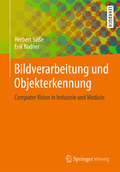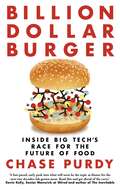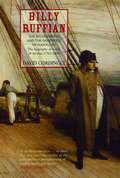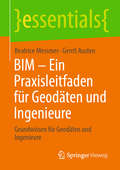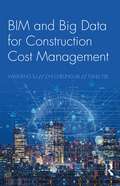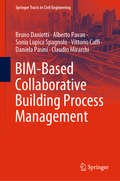- Table View
- List View
Bildverarbeitung in der Automation: Ausgewählte Beiträge des Jahreskolloquiums BVAu 2022 (Technologien für die intelligente Automation #17)
by Volker LohwegIn diesem Open-Access-Tagungsband sind die besten Beiträge des 8. Jahreskolloquiums "Bildverarbeitung in der Automation" (BVAu 2022) enthalten. Das Kolloquium fand am 02. November 2022 auf dem Innovation Campus Lemgo statt.Die vorgestellten neuesten Forschungsergebnisse auf den Gebieten der industriellen Bildverarbeitung erweitern den aktuellen Stand der Forschung und Technik. Die in den Beiträgen enthaltenen anschaulichen Anwendungsbeispiele aus dem Bereich der Automation setzen die Ergebnisse in den direkten Anwendungsbezug.
Bildverarbeitung interaktiv: Eine Einführung mit multimedialem Lernsystem auf CD-ROM (Informatik & Praxis)
by Herbert KoppBildverarbeitung und Objekterkennung: Computer Vision in Industrie und Medizin
by Herbert Süße Erik RodnerDieses Buch erläutert, wie Informationen automatisch aus Bildern extrahiert werden. Mit dieser sehr aktuellen Frage beschäftigt sich das Buch mittels eines Streifzuges durch die Bildverarbeitung. Dabei werden sowohl die mathematischen Grundlagen vieler Verfahren der 2D- und 3D-Bildanalyse vermittelt als auch deren Nutzen anhand von Problemstellungen aus vielen Bereichen (Medizin, industrielle Bildverarbeitung, Objekterkennung) erläutert. Das Buch eignet sich sowohl für Studierende der Informatik, Mathematik und Ingenieurwissenschaften als auch für Anwender aus der industriellen Bildverarbeitung.
The Bile Acids Chemistry, Physiology, and Metabolism: Volume 1: Chemistry
by P. NairThe bile acids as principal end products of cholesterol metabolism occupy a focal position in our understanding of the role of steroids in bio logical systems. The biogenesis of bile acids from cholesterol in higher ani mals, and their functions in regulating sterol metabolism and in gastrointestinal physiology have been elucidated by the development of elegant methodo logical approaches during the last two decades. The molecular pleomorphism exhibited by the bile acids and bile alcohols in the animal kingdom is a classic example of their role in biochemical evolution. The total story of the bile acids, their chemistry, their role in normal and abnormal physiological processes, and their significance in biochemical evolution has never been available in the form of a comprehensive treatise written in the words of those who have contributed to the development of our knowledge in this area. The Bile Acids, in two volumes, will serve to fill this void, and will also bring together information which will prove in valuable to both the biochemist and the medical scientist. We wish to thank Mrs. Sally Wiseman and Mrs. Lillian Haas for their invaluable assistance with the editing of the manuscripts. This work was supported in part by grants AM-02131, General Research Support SS0-1- FR-05479 (P.P.N.), HE-03299, HE-05209, and a National Heart Institute Research Career Award (D.K. ), K6-HE-734, from the National Institutes of Health, United States Public Health Service. P.P.N. Baltimore, Maryland D.K.
Biliary Tract and Gallbladder Biomechanical Modelling with Physiological and Clinical Elements
by Wenguang LiGallstone and other diseases of the biliary tract affect more than around 20% of the adult population. The complications of gallstones, acute pancreatitis and obstructive jaundice, can be lethal. This is the first book to systematically treat biliary tract and gallbladder modelling with physiological and clinical information in a biomechanical context. The book provides readers with detailed biomechanical modelling procedures for the biliary tract and gallbladder based on physiological information, clinical observations and experimental data and with the results properly interpreted in terms of clinical diagnosis and with biomechanical mechanisms for biliary diseases. The text can be used as a reference book for university undergraduates, postgraduates and professional researchers in applied mathematics, biomechanics, biomechanical engineering and biomedical engineering, as well as related surgeons.
Biliary Tract and Gallbladder Biomechanical Modelling with Physiological and Clinical Elements
by Wenguang LiGallstone and other diseases of the biliary tract affect more than around 20% of the adult population. The complications of gallstones, acute pancreatitis and obstructive jaundice, can be lethal. This is the first book to systematically treat biliary tract and gallbladder modelling with physiological and clinical information in a biomechanical context. The book provides readers with detailed biomechanical modelling procedures for the biliary tract and gallbladder based on physiological information, clinical observations and experimental data and with the results properly interpreted in terms of clinical diagnosis and with biomechanical mechanisms for biliary diseases. The text can be used as a reference book for university undergraduates, postgraduates and professional researchers in applied mathematics, biomechanics, biomechanical engineering and biomedical engineering, as well as related surgeons.
Billion Dollar Burger: Inside Big Tech's Race for the Future of Food
by Chase PurdyA fast-paced, gripping insider account of the entrepreneurs and renegades racing to bring lab-grown meat to the world.The trillion-dollar meat industry is one of our greatest environmental hazards; it pollutes more than all the world's fossil-fuel-powered cars. Global animal agriculture is responsible for deforestation, soil erosion and more emissions than air travel, paper mills and coal mining combined. It also depends on the slaughter of more than 60 billion animals per year, a number that is only increasing as the global appetite for meat swells. The whole world seems to be sleepwalking into a food crisis. But a band of doctors, scientists, activists and entrepreneurs have been racing to end animal agriculture as we know it, hoping to fulfill a dream of creating meat without ever having to kill an animal. This is the story of a group of seven vegans quietly working to solve one the most pressing issues we face today, creating the biggest upheaval to the food business in decades along the way. In Billion Dollar Burger, Chase Purdy explores the companies at the cutting edge of the nascent food technology sector, from polarizing activist-turned-tech CEO Josh Tetrick to lobbyists and regulators on both sides of the issue. Billion Dollar Burger follows the people fighting to upend our food system as they butt up against the entrenched interests fighting viciously to stop them. It will take readers on a truly global journey from Silicon Valley to China, by way of Israel and the UK.The stakes are monumentally high: cell-cultured meat is the best hope for sustainable food production, a key to fighting climate change, a gold mine for the companies that make it happen and an existential threat for the farmers and meatpackers that make our meat today.
The Billionaire's Chef: Cooking for the Rich and Famished
by Neal SalisburyA Wonka-Like Journey into an Ultra Private World of Decadence and ExcessFrom cooking for Martha Stewart, SeanPuff Daddy Combs, and Jerry Seinfeld to more than 20 of the world's most reclusive billionaires, Chef Neal Sheldon Salisbury has been serving the world's power elite for more than 15 years. His new book, The Billionaire's Chef: Cooking fo
Billmeyer and Saltzman's Principles of Color Technology
by Roy S. BernsThis book offers detailed coverage of color, colorants, the coloring of materials, and reproducing the color of materials through imaging. It combines the clarity and ease of earlier editions with significant updates about the advancement in color theory and technology. Provides guidance for how to use color measurement instrumentation, make a visual assessment, set a visual tolerance, and select a formulation Supplements material with numerical examples, graphs, and illustrations that clarify and explain complex subjects Expands coverage of topics including spatial vision, solid-state lighting, cameras and spectrophotometers, and translucent materials
Billmeyer and Saltzman's Principles of Color Technology
by Roy S. BernsThis book offers detailed coverage of color, colorants, the coloring of materials, and reproducing the color of materials through imaging. It combines the clarity and ease of earlier editions with significant updates about the advancement in color theory and technology. Provides guidance for how to use color measurement instrumentation, make a visual assessment, set a visual tolerance, and select a formulation Supplements material with numerical examples, graphs, and illustrations that clarify and explain complex subjects Expands coverage of topics including spatial vision, solid-state lighting, cameras and spectrophotometers, and translucent materials
Billy Ruffian: The Bellerophon And The Downfall Of Napoleon
by David CordinglyThis is the story of the Bellerophon, a ship of the line known to her crew as the Billy Ruffian. Under fourteen captains, she played a conspicuous part in three of the most famous of all sea battles: the battle of the Glorious First of June (1794), the opening action against Revolutionary France; the battle of the Nile (1798), which halted Napoleon's eastern expansion from Cairo; and the battle of Trafalgar (1805), which established British naval supremacy for 100 years and during which her captain was shot dead with a musket ball an hour before Nelson was mortally wounded. But her crowning glory came six weeks after the Battle of Waterloo, when the Napoleon, trapped in La Rochelle, surrendered to the captain of the ship that had dogged his steps for more than twenty years.
BIM – Ein Praxisleitfaden für Geodäten und Ingenieure: Grundwissen für Geodäten und Ingenieure (essentials)
by Beatrice Messmer Gerrit AustenZiel dieses Essentials ist es, Basiswissen zu Building Information Modeling (BIM) für den Fachbereich der Geodäsie und deren Nachbardisziplinen aus nationaler sowie internationaler Literatur zusammenzufassen und praktische Empfehlungen daraus abzuleiten. Der zunehmende Digitalisierungsgrad bei Bauvorhaben durch die Anwendung von BIM und das steigende Automatisierungspotential klassischer geodätischer Tätigkeiten begründen die Notwendigkeit, betroffene Aufgaben- und Tätigkeitsfelder in der Vermessung weiter zu entwickeln.
BIM and Big Data for Construction Cost Management
by Weisheng Lu Chi Cheung Lai Tung TseThis book is designed to help practitioners and students in a wide range of construction project management professions to understand what building information modelling (BIM) and big data could mean for them and how they should prepare to work successfully on BIM-compliant projects and maintain their competencies in this essential and expanding area. In this book, the state-of-the-art information technologies that support high-profile BIM implementation are introduced, and case studies show how BIM has integrated core quantity surveying and cost management responsibilities and how big data can enable informed decision-making for cost control and cost planning. The authors' combined professional and academic experience demonstrates, with practical examples, the importance of using BIM and particularly the fusion of BIM and big data, to sharpen competitiveness in global and domestic markets. This book is a highly valuable guide for people in a wide range of construction project management and quantity surveying roles. In addition, implications for project management, facilities management, contract administration, and dispute resolution are also explored through the case studies, making this book essential reading for built environment and engineering professionals.
BIM and Big Data for Construction Cost Management
by Weisheng Lu Chi Cheung Lai Tung TseThis book is designed to help practitioners and students in a wide range of construction project management professions to understand what building information modelling (BIM) and big data could mean for them and how they should prepare to work successfully on BIM-compliant projects and maintain their competencies in this essential and expanding area. In this book, the state-of-the-art information technologies that support high-profile BIM implementation are introduced, and case studies show how BIM has integrated core quantity surveying and cost management responsibilities and how big data can enable informed decision-making for cost control and cost planning. The authors' combined professional and academic experience demonstrates, with practical examples, the importance of using BIM and particularly the fusion of BIM and big data, to sharpen competitiveness in global and domestic markets. This book is a highly valuable guide for people in a wide range of construction project management and quantity surveying roles. In addition, implications for project management, facilities management, contract administration, and dispute resolution are also explored through the case studies, making this book essential reading for built environment and engineering professionals.
BIM and Construction Health and Safety: Uncovering, Adoption and Implementation (Spon Research)
by Hamed Golzad Saeed Banihashemi Carol Hon Robin DrogemullerThis book aims to conceptualise the implementation of building information modelling (BIM) in the workplace health and safety (WHS) management of construction projects to reduce occupational accidents. The safety performance of the construction industry has always been a concern across the globe, and this devastating reputation has drawn the concern of many nations. The potential functions of BIM can drastically alter the WHS practices of the construction industry. BIM facilitates WHS information exchange and management and supports better collaboration and project planning through virtual visualisation of the construction WHS management process. Despite an increasing interest in BIM, a successful mechanism for employing BIM in construction WHS management is absent. Therefore, this book aims to fill this dearth by presenting a model for the integration of such innovative interventions with the current industry practices in a practical manner through the proper identification of effective areas and evaluation of their impacts on the key criteria of construction projects and organisations. This approach will foster the implementation of BIM in the current state of WHS management in the industry and can potentially reduce occupational accidents on construction sites. This book is essential reading for researchers and professionals interested in how BIM technology can improve health and safety on construction projects. It is intended for engineers, project managers, construction managers, safety officers and safety managers.
BIM and Construction Health and Safety: Uncovering, Adoption and Implementation (Spon Research)
by Hamed Golzad Saeed Banihashemi Carol Hon Robin DrogemullerThis book aims to conceptualise the implementation of building information modelling (BIM) in the workplace health and safety (WHS) management of construction projects to reduce occupational accidents. The safety performance of the construction industry has always been a concern across the globe, and this devastating reputation has drawn the concern of many nations. The potential functions of BIM can drastically alter the WHS practices of the construction industry. BIM facilitates WHS information exchange and management and supports better collaboration and project planning through virtual visualisation of the construction WHS management process. Despite an increasing interest in BIM, a successful mechanism for employing BIM in construction WHS management is absent. Therefore, this book aims to fill this dearth by presenting a model for the integration of such innovative interventions with the current industry practices in a practical manner through the proper identification of effective areas and evaluation of their impacts on the key criteria of construction projects and organisations. This approach will foster the implementation of BIM in the current state of WHS management in the industry and can potentially reduce occupational accidents on construction sites. This book is essential reading for researchers and professionals interested in how BIM technology can improve health and safety on construction projects. It is intended for engineers, project managers, construction managers, safety officers and safety managers.
BIM and Construction Management: Proven Tools, Methods, and Workflows
by Brad Hardin Dave McCoolA sleeker, more comprehensive approach to construction projects BIM and Construction Management, Second Edition is a complete integration guide, featuring practical advice, project tested methods and workflows, and tutorials for implementing Building Information Modeling and technology in construction. Updated to align with the latest software editions from Autodesk, Trimble and Bentley, this book provides a common sense approach to leveraging BIM to provide significant value throughout a project's life cycle. This book outlines a results-focused approach which shows you how to incorporate BIM and other technologies into all phases of construction management, such as:Project planning: Set up the BIM project to succeed right from the start by using the right contracts, the right processes and the right technology Marketing: How to exceed customer expectations and market your brand of BIM to win. Pre-construction: Take a practical approach to engineer out risks in your project by using the model early to virtually build and analyze your project, prior to physical construction. Construction: Leverage the model throughout construction to build safer and with better quality. Field work: Learn how mobile technologies have disrupted the way we work in the field to optimize efficiencies and access information faster. Closeout: Deliver a better product to your customer that goes beyond the physical structure and better prepares them for future operations. Additionally, the book provides a look at technology trends in construction and a thoughtful perspective into potential use cases going forward. BIM and Construction Management, Second Edition builds on what has changed in the construction landscape and highlights a new way of delivering BIM-enabled projects. Aligning to industry trends such as Lean, integrated delivery methods, mobile platforms and cloud-based collaboration this book illustrates how using BIM and technology efficiently can create value.
BIM and Construction Management: Proven Tools, Methods, and Workflows
by Brad Hardin Dave McCoolA sleeker, more comprehensive approach to construction projects BIM and Construction Management, Second Edition is a complete integration guide, featuring practical advice, project tested methods and workflows, and tutorials for implementing Building Information Modeling and technology in construction. Updated to align with the latest software editions from Autodesk, Trimble and Bentley, this book provides a common sense approach to leveraging BIM to provide significant value throughout a project's life cycle. This book outlines a results-focused approach which shows you how to incorporate BIM and other technologies into all phases of construction management, such as:Project planning: Set up the BIM project to succeed right from the start by using the right contracts, the right processes and the right technology Marketing: How to exceed customer expectations and market your brand of BIM to win. Pre-construction: Take a practical approach to engineer out risks in your project by using the model early to virtually build and analyze your project, prior to physical construction. Construction: Leverage the model throughout construction to build safer and with better quality. Field work: Learn how mobile technologies have disrupted the way we work in the field to optimize efficiencies and access information faster. Closeout: Deliver a better product to your customer that goes beyond the physical structure and better prepares them for future operations. Additionally, the book provides a look at technology trends in construction and a thoughtful perspective into potential use cases going forward. BIM and Construction Management, Second Edition builds on what has changed in the construction landscape and highlights a new way of delivering BIM-enabled projects. Aligning to industry trends such as Lean, integrated delivery methods, mobile platforms and cloud-based collaboration this book illustrates how using BIM and technology efficiently can create value.
BIM and Quantity Surveying
by Peter Sell Steve PittardThe sudden arrival of Building Information Modelling (BIM) as a key part of the building industry is redefining the roles and working practices of its stakeholders. Many clients, designers, contractors, quantity surveyors, and building managers are still finding their feet in an industry where BIM compliance can bring great rewards. This guide is designed to help quantity surveying practitioners and students understand what BIM means for them, and how they should prepare to work successfully on BIM compliant projects. The case studies show how firms at the forefront of this technology have integrated core quantity surveying responsibilities like cost estimating, tendering, and development appraisal into high profile BIM projects. In addition to this, the implications for project management, facilities management, contract administration and dispute resolution are also explored through case studies, making this a highly valuable guide for those in a range of construction project management roles. Featuring a chapter describing how the role of the quantity surveyor is likely to permanently shift as a result of this development, as well as descriptions of tools used, this covers both the organisational and practical aspects of a crucial topic.
BIM and Quantity Surveying
by Peter Sell Steve PittardThe sudden arrival of Building Information Modelling (BIM) as a key part of the building industry is redefining the roles and working practices of its stakeholders. Many clients, designers, contractors, quantity surveyors, and building managers are still finding their feet in an industry where BIM compliance can bring great rewards. This guide is designed to help quantity surveying practitioners and students understand what BIM means for them, and how they should prepare to work successfully on BIM compliant projects. The case studies show how firms at the forefront of this technology have integrated core quantity surveying responsibilities like cost estimating, tendering, and development appraisal into high profile BIM projects. In addition to this, the implications for project management, facilities management, contract administration and dispute resolution are also explored through case studies, making this a highly valuable guide for those in a range of construction project management roles. Featuring a chapter describing how the role of the quantity surveyor is likely to permanently shift as a result of this development, as well as descriptions of tools used, this covers both the organisational and practical aspects of a crucial topic.
BIM and Urban Land Administration
by Abbas Rajabifard Behnam Atazadeh Mohsen KalantariRapid urbanization has created an unprecedented pressure on the use of land in cities around the world, resulting in physical and legal complexities. This book explains the theoretical basis and practicality of connecting urban land administration practices with the 3D digital data environment of Building Information Modelling (BIM). The main focus is to adopt a BIM-based paradigm for enhancing communication and management of complex ownership rights in multi-story buildings, which are prevalent in urban built environments. This book first elaborates on a range of data elements required for managing legal information in current land administration practices pertaining to subdivision of legal interests within multi-story building developments. It then explains how an open data model in the BIM domain – Industry Foundation Classes (IFC) – can be extended with legal data elements to lay the foundation for adopting BIM in urban land administration. The book also highlights benefits and barriers of implementing BIM-enabled urban land administration. Features Explains the theoretical basis and practicality of connecting urban land administration practices with the 3D digital data environment of BIM. Highlights the existing challenges associated with current practice of urban land administration for multi-story buildings. Introduces the potential of 3D digital environment of BIM for the purpose of mapping and registering legal interests. Describes how BIM-based data models can be extended for recording, managing, and representing legal ownership of properties over a building's lifecycle. Includes models of multi-story buildings as case studies to demonstrate the feasibility of extended BIM-based data models.
BIM and Urban Land Administration
by Abbas Rajabifard Behnam Atazadeh Mohsen KalantariRapid urbanization has created an unprecedented pressure on the use of land in cities around the world, resulting in physical and legal complexities. This book explains the theoretical basis and practicality of connecting urban land administration practices with the 3D digital data environment of Building Information Modelling (BIM). The main focus is to adopt a BIM-based paradigm for enhancing communication and management of complex ownership rights in multi-story buildings, which are prevalent in urban built environments. This book first elaborates on a range of data elements required for managing legal information in current land administration practices pertaining to subdivision of legal interests within multi-story building developments. It then explains how an open data model in the BIM domain – Industry Foundation Classes (IFC) – can be extended with legal data elements to lay the foundation for adopting BIM in urban land administration. The book also highlights benefits and barriers of implementing BIM-enabled urban land administration. Features Explains the theoretical basis and practicality of connecting urban land administration practices with the 3D digital data environment of BIM. Highlights the existing challenges associated with current practice of urban land administration for multi-story buildings. Introduces the potential of 3D digital environment of BIM for the purpose of mapping and registering legal interests. Describes how BIM-based data models can be extended for recording, managing, and representing legal ownership of properties over a building's lifecycle. Includes models of multi-story buildings as case studies to demonstrate the feasibility of extended BIM-based data models.
BIM-Based Collaborative Building Process Management (Springer Tracts in Civil Engineering)
by Bruno Daniotti Alberto Pavan Sonia Lupica Spagnolo Vittorio Caffi Daniela Pasini Claudio MirarchiThe book reports on the great improvements in the information and knowledge management due to the digitalization of the building sector. By summarizing several research projects addressing the implementation of BIM in different stages of the building process, and the definition of standards at Italian, European and international levels for managing information relying on the implementation of BIM-based processes, it showcases the efforts, especially within the Italian building sector, to build a standardized structure of information and develop tools for collecting, sharing and exchanging information between stakeholders involved in different stages of the building process, so as to enhance the storage, traceability, usability and re-usability of information management. Further, it presents an enhanced use of information that relies on the adoption of the standardized structure of information, and proposes dedicated applications for automating the process of information fruition. Lastly, it features a digital platform for different stakeholders in the building sector, such as manufacturers, producers and construction companies.
BIM for Construction Health and Safety
by Stefan Mordue Roland FinchWhat is BIM and how does it affect the health and safety professional? How are BIM technologies used on a practical level? What opportunities are there for the use of BIM in the health and safety arena? This concise and practical guide aims to answer all these questions and more. The health and safety role is evolving towards collaboration, structured data and sharing of information as BIM – the incarnation of these sensibilities - increasingly underpins construction practice. As the industry begins to see how these two topics can and should intersect this guide provides context and practical advice by explaining the basic principles of BIM, how it will shape the health and safety professional’s role and what tools and processes will need to be embedded in the future. It also highlights the wealth of opportunities that BIM provides to improve health and safety standards and effective coordination – the means to exploit the potential of BIM.
BIM for Construction Health and Safety
by Stefan Mordue Roland FinchWhat is BIM and how does it affect the health and safety professional? How are BIM technologies used on a practical level? What opportunities are there for the use of BIM in the health and safety arena? This concise and practical guide aims to answer all these questions and more. The health and safety role is evolving towards collaboration, structured data and sharing of information as BIM – the incarnation of these sensibilities - increasingly underpins construction practice. As the industry begins to see how these two topics can and should intersect this guide provides context and practical advice by explaining the basic principles of BIM, how it will shape the health and safety professional’s role and what tools and processes will need to be embedded in the future. It also highlights the wealth of opportunities that BIM provides to improve health and safety standards and effective coordination – the means to exploit the potential of BIM.


